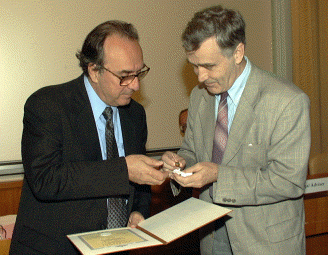Geneva, 23 June 2000. The CERN1 Council, where the representatives of the 20 Member States of the Organization decide on scientific programmes and financial resources, held its 115th session today under the chairmanship of Dr. Hans C. Eschelbacher (DE).
Geneva, 23 June 2000. The CERN1 Council, where the representatives of the 20 Member States of the Organization decide on scientific programmes and financial resources, held its 115th session today under the chairmanship of Dr. Hans C. Eschelbacher (DE).
Director General's Status Report
The Director General, Prof. Luciano Maiani, began his report with the performance of the Laboratory's flagship accelerator, the Large Electron-Positron collider, LEP, during its final year. LEP is achieving its highest energy collisions ever with beams of over 104 GeV, well exceeding its design energy and giving experiments a final chance of discovering the still-elusive Higgs particles before the end of it's experimental programme in September. Thanks to precision data from LEP and elsewhere, scientists already know that Higgs particles, if they exist, must be within range of LEP's successor, the LHC.
Prof. Maiani described other aspects of the Laboratory's ongoing research programme. The NA48 experiment continues to study nature's preference for matter over antimatter. The COMPASS experiment will soon extend CERN's long tradition of research over a wide range of nuclear and sub-nuclear physics. The heavy-ion programme, which in February 2000 announced the first indications of the state of matter which must have existed just after the Big Bang, will resume at the SPS and subsequently with the ALICE experiment at the LHC. Until then the heavy-ion relay passes to the US Brookhaven laboratory, which the Director General congratulated on the recent start up of the RHIC heavy-ion collider.
Three new facilities are helping to preserve the diversity of CERN research. A neutron Time-of-Flight system will complement the Laboratory's long-standing ISOLDE, covering fields as diverse as biomedical research and nuclear physics. The Antiproton Decelerator will start taking experimental data later in the year, with the exciting prospect of creating significant numbers of antihydrogen atoms. And in 2005 the CERN Neutrinos to Gran Sasso project will join the global effort to understand the behaviour of neutrinos.
LHC Progress
Taking over 60% of the Laboratory's material resources and approaching half of its manpower, the LHC is now CERN's core activity. With the exception of some civil engineering delays, now overcome, the new machine remains on schedule and within budget with nearly 60% of the total expenditure adjudicated. The global collaboration to build the new machine is working well, with components arriving at CERN from all over the world and Web-based project management tools being put into place. The construction of the detectors for the new machine is also progressing well, though delays inevitable in such a complex undertaking have been encountered. The collaborations will, however, ensure that working detectors will be in place on day one of accelerator operation.
Investing in the Future
Looking to the long-term future of CERN, the Director General pointed out that now is the time for a vigorous programme of accelerator R&D to be put in place. The Compact Linear Collider project, CLIC, will enter a new phase next year when a new test facility can be installed in buildings currently occupied by the pre-injector for LEP. A new programme of R&D into high-intensity proton accelerators is getting off the ground with a view to producing a second-generation neutrino beam. CERN is also sharing its expertise in superconducting accelerating cavity technology with other laboratories, notably DESY in Hamburg. These efforts are being co-ordinated within the global accelerator R&D framework, and are currently being supported at a level of around 1% of CERN's resources. The Director General indicated that this is acceptable during the construction phase of the LHC, but said that he believes it is time to start a gradual increase.
Technology and knowledge transfer are increasingly important for CERN and the Laboratory is taking a structured approach to the issue. The Director General gave an overview of CERN technologies that have potential applications beyond particle physics. From dedicated accelerators and detectors for medicine, these ranged through vacuum and thin-film technologies to the GRID - the next generation Internet for which the LHC will be an ideal global test-bed.
Staff and Budget
The budget is set to remain constant in 2000 prices until 2004. Prof. Maiani pointed out that CERN's staffing profile is changing. Within the context of a consistent decrease in the number of staff, the percentage of staff working as manual workers and craftsmen has fallen whilst the percentage of physicists and engineers has risen. Much effort has gone into outsourcing a number of non-core activities. He underlined that resources were barely sufficient and more manpower would be necessary for a vigorous R&D research programme to ensure the future of CERN.
Senior staff appointments
Dr K. Hubner (AT) was re-appointed as Director of Accelerators from 1 January 2001 to 30 June 2001.
Dr C. Wyss (CH) was appointed as Director of Accelerators from 1 July 2001 to 31 December 2003.
Prof. G. Goggi (IT) was re-appointed as Leader of the EP Division from 1 January 2001 to 30 June 2001.
Dr. W-D. Schlatter (DE) was appointed as Leader of the EP Division from 1 July 2001 to 30 June 2004.
Elections
Professor W. Majerotto (AT) was re-elected Vice-President of Council for a period of one year as of 1 July 2000.
Professor W. Buchmüller (DE) was elected as a new member of the Scientific Policy Committee for three years from 1 July 2000.
Professor P. Strolin (IT) was elected as a new member of the Scientific Policy Committee for three years from 1 January 2001.

